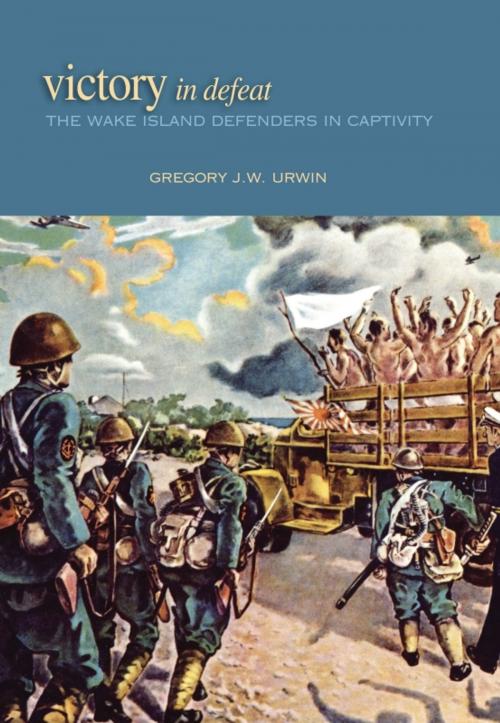| Author: | Gregory J. W. Urwin | ISBN: | 9781612510040 |
| Publisher: | Naval Institute Press | Publication: | January 15, 2011 |
| Imprint: | Naval Institute Press | Language: | English |
| Author: | Gregory J. W. Urwin |
| ISBN: | 9781612510040 |
| Publisher: | Naval Institute Press |
| Publication: | January 15, 2011 |
| Imprint: | Naval Institute Press |
| Language: | English |
Told here for the first time in vivid detail is the story of the defenders of Wake Island following their surrender to the Japanese on December 23, 1941. The highly regarded military historian Gregory Urwin spent decades researching what happened and now offers a revealing look at the U.S. Marines, sailors, soldiers, and civilian contractors in captivity. In addition to exhaustive archival research, he interviewed dozens of POWs and even some of their Japanese captors. He also had access to diaries secretly kept by the prisoners. This information has allowed Urwin to provide a nuanced look at the Japanese guards and how the Americans survived three-and-a-half years in captivity and emerged with a much lower death rate than most other Allied personnel captured in the Pacific.
In part, Urwin says, the answer lies in the Wake Islanders’ establishment of life-saving communities that kept their dignity intact. Their mutual-help networks encouraged those who faltered under physical and psychological torture, including what is today called water boarding. The book notes that the Japanese camp official responsible for that war crime was sentenced to life imprisonment by an American military tribunal. Most Wake Islanders spent the war at two camps just outside Shanghai, one of the few places where Japanese authorities permitted the Red Cross to aid prisoners of war. The author also calls attention to the generosity of civilians in Shanghai, including Swiss diplomats and the American and British residents of the fabled International Settlement, who provided food and clothing to the prisoners. In addition, some guards proved to be less vicious than those stationed at other POW camps and occasionally went out of their way to aid inmates. As the first historical work to fully explore the captivity of Wake Island’s defenders, the book offers information not found in other World War II histories.
In part, Urwin says, the answer lies in the Wake Islanders’ establishment of life-saving communities that kept their dignity intact. Their mutual-help networks encouraged those who faltered under physical and psychological torture, including what is today called water boarding. The book notes that the Japanese camp official responsible for that war crime was sentenced to life imprisonment by an American military tribunal. Most Wake Islanders spent the war at two camps just outside Shanghai, one of the few places where Japanese authorities permitted the Red Cross to aid prisoners of war. The author also calls attention to the generosity of civilians in Shanghai, including Swiss diplomats and the American and British residents of the fabled International Settlement, who provided food and clothing to the prisoners. In addition, some guards proved to be less vicious than those stationed at other POW camps and occasionally went out of their way to aid inmates. As the first historical work to fully explore the captivity of Wake Island’s defenders, the book offers information not found in other World War II histories.
Told here for the first time in vivid detail is the story of the defenders of Wake Island following their surrender to the Japanese on December 23, 1941. The highly regarded military historian Gregory Urwin spent decades researching what happened and now offers a revealing look at the U.S. Marines, sailors, soldiers, and civilian contractors in captivity. In addition to exhaustive archival research, he interviewed dozens of POWs and even some of their Japanese captors. He also had access to diaries secretly kept by the prisoners. This information has allowed Urwin to provide a nuanced look at the Japanese guards and how the Americans survived three-and-a-half years in captivity and emerged with a much lower death rate than most other Allied personnel captured in the Pacific.
In part, Urwin says, the answer lies in the Wake Islanders’ establishment of life-saving communities that kept their dignity intact. Their mutual-help networks encouraged those who faltered under physical and psychological torture, including what is today called water boarding. The book notes that the Japanese camp official responsible for that war crime was sentenced to life imprisonment by an American military tribunal. Most Wake Islanders spent the war at two camps just outside Shanghai, one of the few places where Japanese authorities permitted the Red Cross to aid prisoners of war. The author also calls attention to the generosity of civilians in Shanghai, including Swiss diplomats and the American and British residents of the fabled International Settlement, who provided food and clothing to the prisoners. In addition, some guards proved to be less vicious than those stationed at other POW camps and occasionally went out of their way to aid inmates. As the first historical work to fully explore the captivity of Wake Island’s defenders, the book offers information not found in other World War II histories.
In part, Urwin says, the answer lies in the Wake Islanders’ establishment of life-saving communities that kept their dignity intact. Their mutual-help networks encouraged those who faltered under physical and psychological torture, including what is today called water boarding. The book notes that the Japanese camp official responsible for that war crime was sentenced to life imprisonment by an American military tribunal. Most Wake Islanders spent the war at two camps just outside Shanghai, one of the few places where Japanese authorities permitted the Red Cross to aid prisoners of war. The author also calls attention to the generosity of civilians in Shanghai, including Swiss diplomats and the American and British residents of the fabled International Settlement, who provided food and clothing to the prisoners. In addition, some guards proved to be less vicious than those stationed at other POW camps and occasionally went out of their way to aid inmates. As the first historical work to fully explore the captivity of Wake Island’s defenders, the book offers information not found in other World War II histories.















